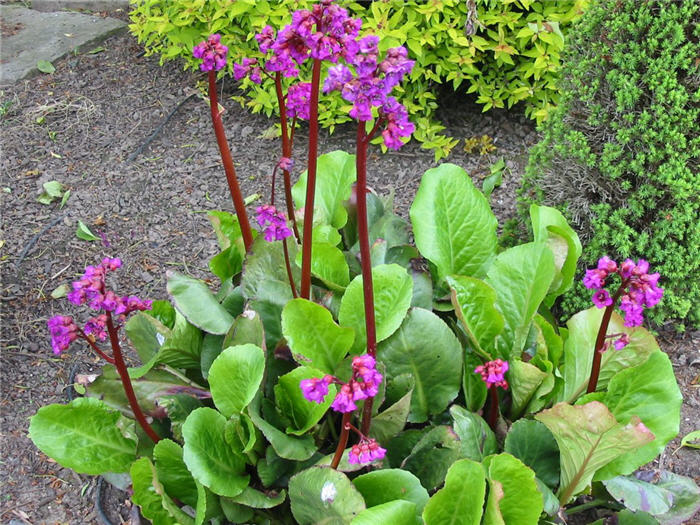| Botanical Name: Bergenia 'Bressingham Ruby' | |
| Common Name: Bressingham Ruby Bergenia |

-
Anatomy
-
Culture
-
Design
Plant Type
Broadleaf Evergreen, Ground cover, Perennial
Height Range
1-3'
Flower Color
Red
Flower Season
Spring
Leaf Color
Bronze, Green, Light Green
Bark Color
n/a
Fruit Color
n/a
Fruit Season
n/a
Sun
Half, Shade
Water
Medium
Growth Rate
Moderate
Soil Type
Clay, Loam, Rocky, Unparticular
Soil Condition
Average, Rich, Poor, Well-drained
Soil pH
Neutral, Basic
Adverse Factors
n/a
Design Styles
English Cottage, Japanese, Meadow, Mediterranean, Ranch, Seascape, Spanish, Tropical, Woodland
Accenting Features
Showy Flowers, Unusual Foliage
Seasonal Interest
Winter, Spring, Summer, Fall
Location Uses
Entry, Perennial Border, Shrub Border, Foundation, Parking Strip, Walkways
Special Uses
Cut Flowers, Mass Planting, Small Spaces
Attracts Wildlife
n/a
Information by: Stephanie Duer
Photographer:
Photographer:
-
Description
-
Notes
Bergenia has evergreen, round, heart-shaped, glossy, thick leaves, frequently with fine toothed edges. The leaves are basically stemless, growing off of a shallow rhizome, so, though the leaves are large, the plant has a fairly low profile. It is this juxtaposition of low-growing and big-leaf that makes bergenia so a fine addition to the shade border. Flowers bloom in spring; Bressingham Ruby has rosy red flowers and red-bronze tinted winter foliage. Grows 12 to 16" tall and 12 to 18" wide.
Grow in average to loamy well-drained soil in part to full shade. Though the leaves are evergreen, they can come out of winter a bit tattered so cut them off in spring as new growth emerges. Remove spent flower stalks. Bergenia is excellent in dry to medium dry shady areas, and pairs well with Corydalis, Alchemilla, Columbine, and the shadier geraniums.